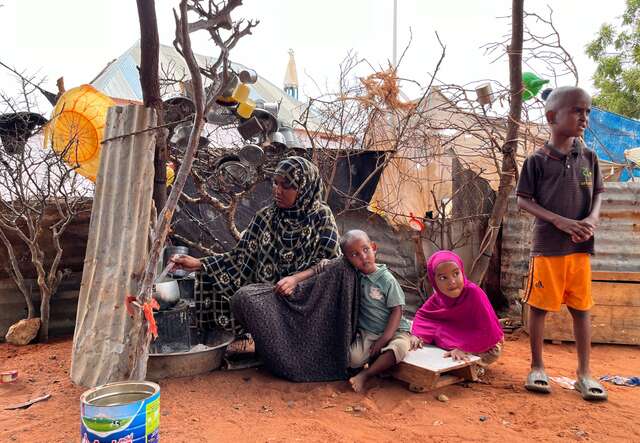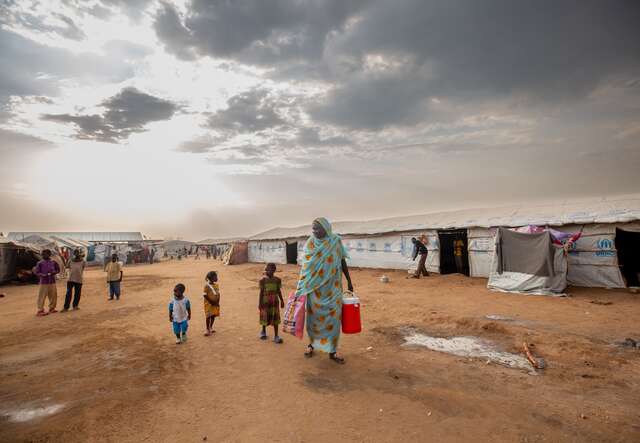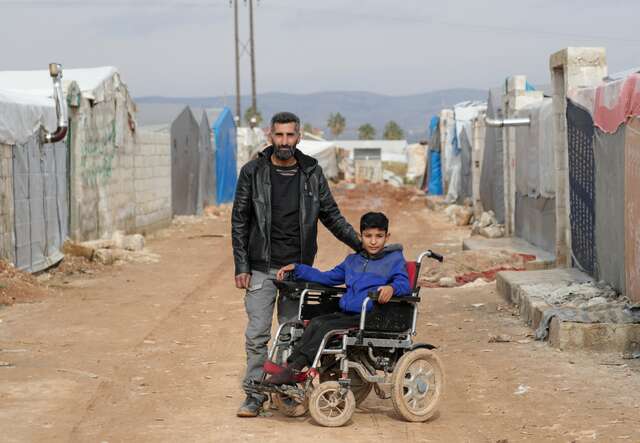
The top 10 crises the world can’t ignore in 2025
We are living in a world out of balance. Find out what is driving the most pressing humanitarian crises around the world.

We are living in a world out of balance. Find out what is driving the most pressing humanitarian crises around the world.
Each year, the International Rescue Committee’s (IRC) Emergency Watchlist pinpoints the countries most likely to face escalating humanitarian crises. Considering the likelihood and effects of war, economic instability, climate change and more, the list highlights twenty places that are bearing the brunt of a world increasingly out of balance. Despite comprising only 11% of the world’s population, these countries account for a disproportionate 82% of people in need of humanitarian aid.
Read on to learn more about the top ten countries on the list and find out how the IRC is delivering lifesaving support to the communities most impacted.
For the third consecutive year, Somalia remains on the Emergency Watchlist’s top 10. Al-Shabaab, a powerful armed group, conducted more than 120 attacks in the first nine months of 2024 and its influence could expand as the African Union’s stabilization mission (ATMIS) prepares to withdraw from the country. Meanwhile, rising inter-clan conflict has fueled instability.
Climate shocks also pose an enormous threat to the East African nation. Somalia is still recovering from a catastrophic drought that lasted from 2021 to 2023 and worsened hunger and childhood acute malnutrition across the country. Yet, despite Somalia’s extreme vulnerability to climate change, it has received less than 0.1% of global climate finance funding.

The IRC started its work in Somalia in 1981, with our current continuous operation beginning in 2007. The IRC works in key regions like Banadir, Puntland, South West, Jubaland and Hirshabelle. We assist families by providing health care for malnourished children, giving cash transfers with no conditions, rehabilitating water sources and offering mobile health services in severely affected areas.
Learn more about the IRC’s Somalia response.
Hunger in Mali is getting worse due to an escalating conflict that has been raging for twelve years. More cities are under siege, with the Malian military government and the Russian Wagner Group fighting against armed factions like the Tuareg forces, Islamic State in the Greater Sahara (ISGS) and Jama’at Nusrat al-Islam wal-Muslimin (JNIM). The exit of United Nations and French military support has led to an increase in civilian casualties, with reports suggesting that the Malian military and Wagner forces are now responsible for more civilian killings than JNIM and ISGS. Meanwhile, ISGS and JNIM expanded blockades, cutting off access to food, water and humanitarian aid for hundreds of thousands of people.

Since 2012, the IRC has provided aid to over half a million Malians affected by conflict. These communities face severe food shortages and a lack of essential services such as health care and education. To address this, the IRC is collaborating with partners to gather data and improve its malnutrition treatment programs. The goal is to reach and assist more severely malnourished children in Mali and beyond.
Learn more about the IRC’s Mali response.
Gang violence and governmental dysfunction have thrown Haiti into a state of crisis. President Jovenel Moïse's 2021 assassination exacerbated instability. Criminal gangs have grown stronger and more organized, expanding their influence and causing widespread chaos. Natural disasters like earthquakes and hurricanes have worsened the crisis. They have devastated the country, leaving nearly half the population in severe hunger and extreme poverty.

The IRC has been supporting Haiti since 2010, working with civil society organizations to meet community needs. In December 2022, the IRC launched a new emergency response, partnering with trusted organizations that have long supported Haitians. Together, we focus on cholera prevention, health care, clean water and sanitation, child protection and addressing gender-based violence.
Burkina Faso remains in the top 10 of the Emergency Watchlist for the third year running. Armed groups, like ISGS and JNIM, have displaced millions. Their brutal campaigns have devastated communities across the country and the wider Sahel region. Armed groups have isolated nearly 40 towns, an increase from just one in 2021. This has cut off about 2 million people from the rest of the country and disrupted vital aid. Attacks on hospitals, schools and communities are putting civilians in greater danger.

The IRC began emergency response efforts in Burkina Faso in 2019 and launched an official country program in 2020. We provide essential support in health, nutrition, safety, education and economic recovery. We also focus on empowering communities by partnering with local organizations, particularly those led by women, to drive lasting change.
Learn more about the IRC’s Burkina Faso response.
A deadly new phase of conflict between Hezbollah and Israel pushes Lebanon into the top 10 of the Emergency Watchlist for the first time.
Hezbollah and Israel agreed to a ceasefire on November 27, 2024, bringing a level of relative calm after two months of intense ground combat and airstrikes—and over a year of cross-border fire. However, a ceasefire alone does not end the acute humanitarian need. The conflict caused devastation, forcing 1.4 million people to flee their homes in Lebanon and displacing 60,000 in northern Israel. It also came after a multiyear economic crisis that has weakened the health care system and left record numbers of people going hungry.

Since 2012, the IRC has supported Lebanese citizens and refugees. In September 2024, we responded quickly to the conflict, delivering emergency aid. We work with local partners to assist displaced people, providing meals, financial assistance, shelter, hygiene kits and medical care. These efforts have directly reached tens of thousands of people affected by the crisis.
Learn more about the IRC’s Lebanon response.
South Sudan is in the Emergency Watchlist's top five for the second year in a row. The country faces threats from conflict in neighboring Sudan, political instability and the climate crisis. Violence is widespread, severe annual flooding has caused damage to food production and the country is facing an economic crisis. To add to the challenges, the nation also struggles to meet the needs of 878,000 Sudanese refugees.

Since the conflict in Sudan began, the IRC has been helping refugees and returnees in South Sudan. We provide life-saving health, nutrition and protection services to meet urgent needs and address safety concerns at entry points.
Learn more about the IRC’s South Sudan response.
Syria is back in the top five of the Emergency Watchlist, marking its first appearance since 2021. In late 2024, nonstate armed groups launched a surprise attack, triggering a rapid collapse of government forces. The current situation in Syria remains uncertain. Nonstate armed groups now control Damascus, and President Assad has reportedly fled to Moscow. After years of relative stability, the conflict has escalated, affecting millions of Syrians in their 14th year of war. This conflict has led to the world's second-largest displacement crisis, with 13.8 million people forced out of their homes, and pushed the population into widespread poverty. Whether the recent, momentous shifts will allow Syrians to rebuild their lives in 2025 or deepen the crisis remains unanswered.

The IRC has been working in Syria since 2012 and is currently responding to needs in northern Syria, directly and in partnership with local organizations. We provide lifesaving health care, including support for health facilities and mobile health teams. We deliver counseling and protection services for women and children, particularly survivors of violence. We also provide cash assistance, early recovery and early childhood development support.
Learn more about how the IRC is making a difference in Syria.
Myanmar is in the top three of the Emergency Watchlist for the first time due to escalating conflict and climate disasters. Violence has worsened since the military took control in 2021. Long-standing insurgencies have spread and merged into a wider conflict, leading to the displacement of over 3 million people. In addition, cyclones and floods continue to devastate communities. The country's water and health systems, which were already affected by war, are not prepared to handle the increasing needs.

In 2008, the IRC responded to Cyclone Nargis in Myanmar. Since then, our efforts have broadened. We help those affected by the 2021 conflict and support displaced communities, covering multiple sectors in Rakhine, Chin, Kachin, Shan, Kayah and Kayin states.
Learn more about the IRC’s Myanmar response.
More than a year of conflict has devastated Gaza. The latest escalation began in October 2023 when Hamas and other armed groups attacked southern Israel, killing 1,200 people and taking over 200 hostages. In response, Israel launched airstrikes and ground operations against Hamas, with the conflict sparking an ongoing humanitarian catastrophe.
There is no safe place in Gaza: over 1 in 50 people there have been killed since October 2023. Civilians in the West Bank have also faced record-level challenges due to Israeli military operations and settler violence in 2024.
In Gaza, the IRC provides clean drinking water, malnutrition treatment and child protection and mental health services. We also support emergency medical care in the few hospitals still functioning. In the West Bank, the IRC and our partners provide mental health, protection and early childhood development services. We also provide medical supplies and strengthen hospitals for mass casualty care.
Learn more about the IRC’s oPt response.
For the second year in a row, Sudan tops the Emergency Watchlist as the country’s brutal civil war continues. Sudan now accounts for the largest humanitarian crisis on record and the world’s largest and fastest displacement crisis.
The war between the Sudanese Armed Forces (SAF) and the Rapid Support Forces (RSF) is having a devastating impact on civilians. International humanitarian law is being blatantly ignored. Sexual violence and the recruitment of child soldiers have become common as both sides regularly target civilians amid reports of ethnic cleansing. Regular attacks on health care and humanitarian aid have left civilians without access to lifesaving services.

When the conflict began in 2023, the IRC adapted our programs and increased our response to meet rising needs. Today, we continue to provide support in Blue Nile, Gedaref, Khartoum, River Nile and White Nile states. We also have a logistics and coordination office in Port Sudan. The IRC is exploring opportunities to expand our presence into other states.
Learn more about the IRC’s Sudan response.
Donate now to support the IRC's life-changing work in Sudan and worldwide. We are on the frontlines providing critical aid to crisis-affected people in more than 40 countries around the world.
Read our full analysis in the 2025 Emergency Watchlist.
*Pseudonym used for privacy